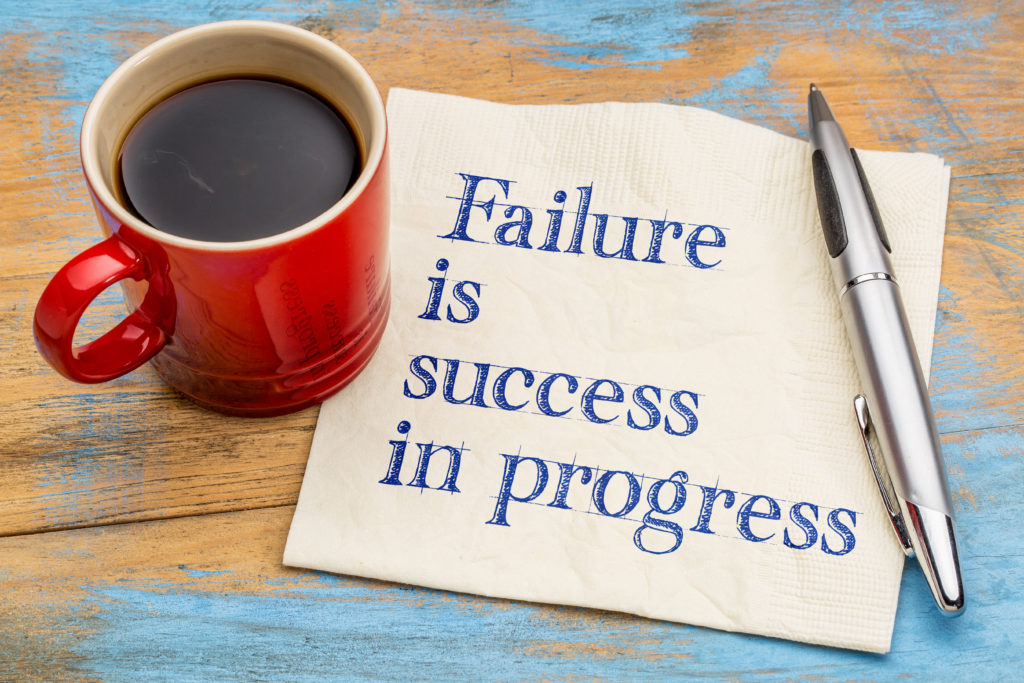This is the third in a series of 12 articles on leadership issues and the characteristics of successful leaders. Join us on a journey and become a more fearless leader. (For the beginning of the series, click here.)
Fear is the background noise for many people, a constant din that keeps us hyper-vigilant, always on the lookout for trouble and dealing with limits that define our lives. We’re battered by fear every day, listening to news stories that justify our uncertainties.
When I ask clients about their biggest fear, what I hear most is: fear of failure.
We are a society of overachievers, and for many, failure is not an option. We’re expected to produce the right results every time. We learn early in life that failure brings humiliation. We must succeed, no matter what.
But here’s the truth:
It’s not our failures that limit who we are, but the belief that our failures define us.
We stop ourselves from grabbing the golden ring of success because we don’t know if we can reach it. We play from the sidelines, watching others take risks, and wishing we could do that. We hold ourselves back before we’ve even had a chance to find out how far we can go.
We are ALL afraid of failing in some way.
Do I fear being seen as incapable? Am I afraid of making a final decision because it could be wrong?
When you avoid failure, you also avoid risk. Without risk, there is no innovation or moving forward. In America, aggressive, forward-thinking CEOs often tell their direct reports, “If you haven’t failed at least three times today, you’re not trying anything new.”
So how do we get over believing that failure defines us?
One good question to ask of each seemingly unsuccessful situation: What did I learn?
FEAR LIMITS PERFORMANCE AND UNDERMINES POTENTIAL SUCCESS

I’ve facilitated dozens of 360° assessments for clients to analyze specific behaviors that help individuals and organizations make measurable improvements at work and in their personal lives. During this work, it’s become clear that fear is a core issue for many in the workplace.
Fear operates below the surface and keeps you from living and working at your highest level of engagement. Considering the large number of disengaged workers and the extent of their disengagement (53% not engaged, 13% totally disengaged, according to a 2019 Gallup survey), it becomes apparent that many fear-induced behaviors work against people’s own interests, undermine aspects of their existence, and negatively impact organizations. How can leaders connect with that 66%?
These statistics show an often-untapped opportunity for companies to increase performance and profitability: helping provide belonging, empowerment, and meaning for employees. [callout] When companies truly believe that employees are their best assets, employee care and support are given high priority. And thriving companies strategically engage workers in growth and development programs.
Fear is insidious for both employees and leaders. Fear can warp your mind, corrupt your actions, and lead you down a fictitious path. How can you learn to alleviate your fear and anxiety, and encourage fearless behaviors in your team?
THE PHYSICAL ASPECTS OF FEAR

For the average person, fear is mostly imagination based. Unless there is a physical threat or you have empirical evidence, fear is a feeling, an emotional response to uncertainty.
Fear is a physical and psychological response built into our DNA. An ancient part of our brain known as the amygdala produces the fight-or-flight reaction, an instinctive response to feelings of threat. This is the point where we decide if we should stand our ground or run.
The amygdala does not distinguish between real and imagined threats.
When your amygdala is activated, you make up stories to explain and validate your feelings of anxiety, stress, confusion or uncertainty. As your prefrontal cortex or executive brain develops, you can begin to question and take a more analytical approach to make sense of perceived threats. You may discover that many of your fears are based in imagination.
You can run, hide, defend, deny, blame, or control; or you can look fear square in the face and ask, What’s that about? Why am I having this reaction? By identifying the fears holding you back and learning how you can overcome them, you can create the life you desire. That’s how “Feel the fear and do it anyway” works.
Fear is not the same as anxiety. You may be anxious because you’re afraid of something that may or may not happen. The thought of losing your job or your relationship makes you anxious. Anxiety is caused by the uncertainty of not knowing what will happen.
Real fear is more spontaneous. When you’re held up at gunpoint, that’s real fear.
WHAT ARE YOUR TOP THREE FEARS?

Our fears may originate from the stories we tell ourselves: about not having enough to live on, not having the desired level of success, not having the right relationship, not having _________ (fill in the blank), and so much more…forever, ever, and ever!
What stories do you tell yourself that hinder your growth, or stop you from taking the actions you know will lead you forward? Consider the top three things you are fearful about. If they were real, ask yourself:
- What would happen?
- How would I feel?
- What resources could I call on to help me through it?
- What new direction would I take?
- What about this fear really matters to me?
- What would I do differently if I had no fear?
The only guarantee in life is change. We live in uncertainty every single day, with no guarantees that today will end on a happy note. But I can guarantee that if your fears are not life threatening, you can find a way to move beyond them—and past what holds you back from being the best and most authentic version of yourself.
Am I fearful of what other people think? Fearful of being chastised?
When you live in fear, it’s difficult to be vulnerable. You’re always waiting for the hammer to come down on you. You may hide your vulnerability by pretending everything is all right when it’s not. Being afraid to reveal yourself essentially conceals the truth of who you are.
Hope and fear cannot occupy the same space. Invite one to stay. –Maya Angelou
Your fears can keep you bound to the past and apprehensive for the future, when you need to be present for whatever is going on.
You can allow the past to inform WHERE you are today, as opposed to ruling WHO you are today.
Being present every day allows hope for the future, with your feet firmly planted in the here and now.
FLIPPING FAILURE TO SUCCESS

We’ve all done things in life that we’re ashamed of. Admitting our errors means being vulnerable. It also means having the courage to withstand criticism and reactions that come our way.
Am I fearful of speaking up for what I want or need because I am afraid to show vulnerability?
Our internal dialogue is preoccupied with not being seen as inadequate, weak, or stupid. Our desire not to be rejected, abandoned, or ridiculed generates fear. In short, it’s about being vulnerable, and that’s hard to be honest about. Consequently, we often suffer in silence and exhibit behaviors that try to cover up their vulnerabilities. I call this the “Opera of Behaviors,” because these fears frequently are overdramatized.
Everyone feels incapable when starting something new. We all have days when we’re off kilter or exhausted. We may call ourselves names in the heat of the moment—but that doesn’t make them true.
In this moment you have an opportunity to revise your thinking and examine the facts as they really are. What did I learn that I could do differently next time?
The truth is that living in fear is a direct result of not trusting yourself. [callout] Fear is a great excuse for standing still. When you have qualms or hesitate to act, ask, What’s the worst that could happen?
Then ask again, Will it actually be that bad? What evidence do you have? If you have none, you may have made stuff up to quiet your uncertainties, or to label your fear. To release your doubts and move forward, try asking these questions:
- What fears are holding me back? Are they real? What proof do I have?
- What do I need to help shift my thinking or behavior?
- What examples of negative self-talk keep me from taking risks?
- Where do I hide my fear by filling time with busywork and distractions to push the emotion away?
- What could I have done differently, if fear had not interfered?
AN UNCONVENTIONAL LIFE LED TO SUCCESS
I can safely say my life has been unconventional.
I left my home in Scotland at age sixteen with a one-way ticket to London. I spent time in various countries and continents, going down paths that challenged me to explore my best and worst characteristics. I gave birth to children I would not live with, married twice, and showed up in countries where I knew no one. With no money, I found jobs that put a roof over my head but not much else. I drank excessively for a few years, joined Alcoholics Anonymous, and five years later understood it was not the drinking, it was my thinking that was the problem.
There was a significant problem: My head was full of negative chat. An inner voice echoed my father’s words: You will never amount to much. It was a recipe for failure and I was doing my best to prove him right. At the same time, a small inner voice said, you can do better.
Many people believed in me and encouraged me to try harder. My belief in myself was extremely low and I took some convincing. I spent years in different types of therapy, determined to break through old patterns that not only diminished me but also were detrimental to my children’s mental health. Therapists, coaches and mentors showed me how things could be different. Slowly, I began to push beyond my dysfunction and realize how capable I truly was . . . and how I could help others have the same realization.
Fast forward to ten years ago, when I wrote and published The Fearless Factor with the intention to help people who struggle with fear and doubt. The book speaks to the fears and uncertainties we all face in growing up, becoming more confident, and creating our best lives. My goal today is the same: to inspire possibilities in others who struggle with their own uncertainties, and why I wrote The Fearless Factor @ Work.
My passion for helping people change affects everything I do. It’s what gets me out of bed in the middle of the night to write. It motivates me to show up each day with one burning concern: to help people create a life of purpose, meaning and commitment, and to discover inner resources to build the lives they desire.
With self-awareness and an honest questioning process, you can become the person you want to be. A Fearless leader or entrepreneur. A Fearless individual with the courage to change.
All adventures start with the unknown. Are you ready to set your journey in motion and commit to becoming the best version of you?
Jacqueline Wales is a motivational speaker, coach, and the author of The Fearless Factor @ Work, The Fearless Factor and other books. She believes in the power of fearlessness for creating the career and life you want.
I’d love to hear your comments and am happy to answer your questions!

